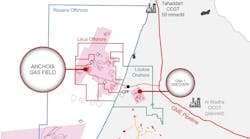Many offshore operators argue that new regulations do not make their operations safer because their voluntary standards were already superior to requirements set forth by the Bureau of Safety and Environmental Enforcement (BSEE). Nevertheless, compliance with that agency's Safety and Environmental Management Systems (SEMS) regulation isnot optional.
Since SEMS was announced just over a year ago, I've heard many offshore operators say they feel they have been meeting SEMS standards for years. But upon further discussion, they admit that they may not have been doing everything to the degree that is now required, especially in terms of documentation. And, as accountability moves higher up the chain of command, the need to make SEMS part of an enterprise sustainability management strategy has never been more important.
Adhering to the 13 elements required for SEMS compliance can be daunting. However, when it is done correctly, the compliance process should help organizations gain new insights and should have positive implications across their operations. So, while some may have thought that the SEMS deadline was much ado about nothing, it should have forced a re-thinking of how the 13 elements are documented and used to drive strategic decisions.
From my experience, six best practices help simplify the process and drive efficiency while ensuring the safe operation of offshore facilities.
First of all, treat all elements as parts of the sum; not independently. Consider that each SEMS element is the spoke of a wheel, and that the purpose of the wheel is to prevent catastrophic events. Each spoke must remain intact and connected to the wheel in order for the wheel to accomplish its purpose. Information in one area often impacts another, so it must be easily accessible and shared among groups. Limited communication can limit success.
Next, involve stakeholders and experts throughout the asset life cycle. It is important to remember that if you comply with each stage of SEMS fully and correctly the first time, not only will you ensure safety across your operations but also make it more efficient to update and revalidate elements. Bad information leads to bad decisions. Information used on one element serves as a basis in other elements, so it is imperative that all the right people are involved in the right stages.
And remember, the life cycle of the whole process must be accurately identified. When evaluating the safety of your operations, you must identify all possible hazards, including, for example, those from equipment labeled as "out-of-service." As equipment ages, decisions must be made regarding repair, replacement, and decommissioning. Simply turning off a machine does not remove it from SEMS coverage and mechanical integrity oversight. The equipment may no longer be in operation, but it remains an active threat until it is properly disconnected, decommissioned, and disposed.
Another best practice often ignored is to treat each risk assessment as if it were the first. Do not become overconfident in prior process hazard analysis (PHA) results. It is easy to blindly trust in your operations when you have gone several years without incident, but complacency can lead to catastrophe. After several rounds of re-validations, I see companies become overconfident in their PHAs, assuming that previous analyses were performed properly. A poor quality PHA that is revalidated incorrectly just compounds the problem. If a retro-fit is performed, the next revalidation should be a complete re-do.
You also must select the correct methodology at the start. Some facilitators select a risk assessment methodology based on what they perceive as the overall risk of a process. However, it is necessary to consider other variables such as: amount of knowledge and experience with the process based on its time in service; how many changes the process has undergone; the size of the process; and most importantly, the complexity of the process. For example, using a checklist or what-if approach on a complex system may not be appropriate.
And finally, beware of inconsistencies from fragmented business processes or outside contractors. Mergers, acquisitions, and joint ventures happen frequently in our industry. Compounded by the extensive usage of outside contractors and subcontractors, many divergent risk management processes are often in place. Reporting becomes fragmented and key information is only available at a site level. Legacy personnel tend to keep what they know in their own silo. As companies move to standardize process and procedures, they also should consider standardizing and centralizing SEMS documentation and systems.
I do not disagree with my offshore clients who say they already comply with SEMS' operational requirements, but it is apparent that documentation will be the Achilles heel of most SEMS programs. SEMS compliance can be made more efficient and expedited with a common operational risk management solution (ORM) that aggregates and leverages information across the enterprise, from one SEMS element to the next. ORM systems are built on the principles of continuous improvement, providing seamless communication from the operator up to the executives, with customized dashboards and reporting for every level of the company. This is how SEMS compliance can be ensured and transformed into a driver for operational excellence.
Jeff Ladner
Senior Director for EHS and Sustainability Solutions
IHS
This page reflects viewpoints on the political, economic, cultural, technological, and environmental issues that shape the future of the petroleum industry. Offshore Magazine invites you to share your thoughts. Email your Beyond the Horizon manuscript to David Paganie at[email protected].
Offshore Articles Archives
View Oil and Gas Articles on PennEnergy.com


